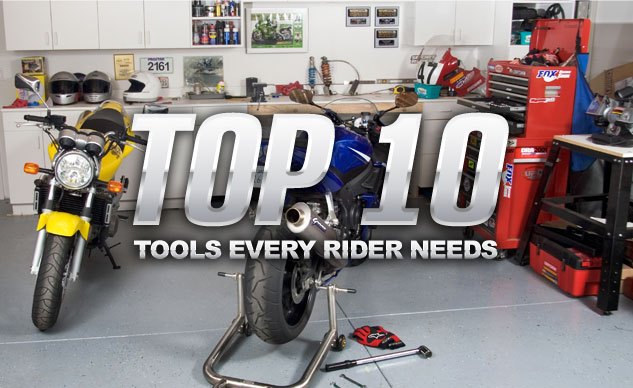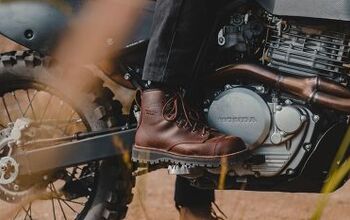Top 10 Tools Every Rider Needs

10.Oil Catch Pan
One of the most basic maintenance tasks a motorcyclist can do is changing the oil of their bike, and Back in the Bad Old Days™, a shade tree mechanic had no qualms about emptying a pan of used motor oil under a bush behind the garage. Well, now we know better. So, get yourself a good oil catch pan that you can seal up and take to your local oil recycling center (usually an auto parts store). If you don’t do this, you’ll slowly add to the toxic chemicals in the water table.
9. Cable Luber
This little tool performs a very simple yet very important job. While you could take all the cables off your bike and hang them in the garage so that you can drip oil through them. Simply clamping this tool over the end of the cable and spritzing some WD-40 or dedicated cable lube through your bikes throttle and clutch cables will keep them operating smoothly and prevent wear. To avoid making a big mess, wrap a rag around the cable’s bottom opening to catch the excess fluid.
8. Variety of Pliers
Yeah, everybody’s got a distant (or maybe not-too-distant) relative who could fix anything with a worn out pair of pliers and some baling wire, but why subject yourself to that challenge. Different jobs require different pliers. Do yourself a favor and get the kinds you need – and don’t cheap out, either. Shown above (from L to R) are: circlip pliers, needle nose pliers, regular old pliers, locking pliers, and safety wire pliers (bottom).
7. Bike Stand
Although the front and rear stands are shown in the photo are more related to sportbikes, having a way to hold your bike upright makes many maintenance tasks much easier. If you’re lucky enough to have a bike with a center stand (rare but not extinct), you can use it for just about all maintenance that doesn’t require the front wheel to be removed. (In that situation, a scissor jack can tilt the bike rearward on the center stand.) If you don’t know what to use for your particular motorcycle, ask at your local shop or favorite online forum. You’ll get pointed in the right direction. Also, check out our recent test of the Bursig Center-Lift Motorcycle Stand.
6. Different Length Wrenches
I remember how, when I bought my first complete set of metric wrenches, I thought I had arrived. That is, until I encountered a situation where I needed two of the same sized wrenches. Or perhaps the space is too small for a full-sized wrench, and only a stubby will do. You’ll probably need at least two sets of wrenches to make your toolbox complete. Among the most used tools in my garage, the ratcheting wrenches (right) are my favorites. They are ideal for the tight confines of a motorcycle.
5. Multi-Meter
A decent multi-meter doesn’t have to be expensive. The cheapie one in the photo gets more use than the big one I spent tons of money on simply because it’s lighter, which allows me to tape it in an easy-to-read location while I’m using it. Use it to check the state of your battery (voltage), look for a short (continuity), or the condition of ignition coils (resistance).
4. Chain Breaker/Riveter
Belt- and shaft-drive bike owners might feel cheated here, but the vast majority of motorcycles are chain driven. So, deal with it. Yes, some chains come with clipable master links to ease in their replacement. However, a riveted chain is much less prone to failure – particularly on today’s high-powered engines. Besides, you never want to experience the sinking feeling of noticing a loose master link that tossed its retaining clip at a gas stop hours from home at, say, 10:00 PM. A good quality chain breaker/riveter (don’t waste your money on one of the cheap Chinese ones) will make replacing a chain and pressing the master link into place take a couple minutes instead of an hour or more. While you may only use it once a year, you’ll be glad you made the investment.
3. Sockets
As you can see from the photo, I’m a little obsessive about sockets. At the very least, you need a set of sockets (in both the 1/4 inch and 3/8 inch varieties). Next, step up to some deep sockets. They’re really quite useful. Hex keys for a 3/8 inch ratchet are extremely utilitarian on motorcycles. The universal joint sockets are nice to have on the rare occasions they’re needed. If want to make your most commonly used sizes easier to find, you can use colored electrical tape to differentiate between them. In this photo, the sizes are: 10mm (white), 12mm (green), 14mm (blue), 17mm (red), and 19mm (black).
2. Torque Wrench
1. Factory Service Manual
While some might argue that the factory service manual is not a tool at all, it is actually the most important tool used in any maintenance or repair you may perform on your bike. Yeah, you can get away with simple things, like oil changes or hydraulic fluid replacement without a manual, but the service manual has descriptions of all disassembly techniques and how to test or measure parts to see if they need replacement. It’ll tell you how to adjust your valves or when your brake discs have reached their minimum thickness. You can use it to trace the wiring diagram for adding accessories or solve an intermittent electrical issue. Or you can just use it to educate yourself about the inner workings of your motorcycle.

Like most of the best happenings in his life, Evans stumbled into his motojournalism career. While on his way to a planned life in academia, he applied for a job at a motorcycle magazine, thinking he’d get the opportunity to write some freelance articles. Instead, he was offered a full-time job in which he discovered he could actually get paid to ride other people’s motorcycles – and he’s never looked back. Over the 25 years he’s been in the motorcycle industry, Evans has written two books, 101 Sportbike Performance Projects and How to Modify Your Metric Cruiser, and has ridden just about every production motorcycle manufactured. Evans has a deep love of motorcycles and believes they are a force for good in the world.
More by Evans Brasfield






































Comments
Join the conversation
What do you need safety wire pliers for? Are you working on an aircraft?
A working credit card.